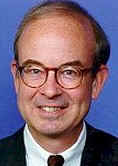| HR 2825 IH, the
Consumer Access to Digital Television Enhancement Act of 2003. Sponsors: Rep. Lee Terry (R-NE), Rep. Rick Boucher (D-VA), and others. Date Introduced: July 23, 2003. Source: The office of Rep. Boucher kindly provided TLJ with a PDF version of the bill. |
 |
 |
||
| Terry | Boucher | |||
108TH CONGRESS
1ST SESSION
H. R. _____
IN THE HOUSE OF REPRESENTATIVES
Mr. TERRY introduced the following bill; which was referred to the Committee on _______
A BILL
To require the Federal Communications Commission to take actions necessary to ensure expeditious access by consumers to terrestrial digital television services.
Be it enacted by the Senate and House of Representatives of the United States of America in Congress assembled,
SECTION 1. SHORT TITLE.
This Act may be cited as the ‘‘Consumer Access to Digital Television Enhancement Act of 2003’’.
SEC. 2. FINDINGS:
The Congress finds the following:
(1) Multiple obstacles exist that prohibit or limit consumers’ access to broadcast digital television services.
(2) Rapid elimination of several of these obstacles is readily achievable and would expand consumer access to digital television services, thus accelerating the transition to DTV, consistent with section 309(j)(14) of the Communications Act of 1934.
(3) Swift adoption of ‘‘plug and play’’ regulations, enabling the manufacture and sale to the public of digital cable-ready televisions, is critical to ensuring access to DTV services by the 70 percent of television households that subscribe to cable.
(4) The ability of televisions marketed or labeled as ‘‘digital cable-ready’’ to also include off-air digital reception capability further expands consumer access to digital television services.
(5) While the DTV transition is burdensome for broadcasters, the adoption of minimum power levels for transmission of digital television signals is important to expand consumer access to digital television services.
(6) In an effort to further the DTV transition, requiring off-the-air digital television broadcast tuners in digital cable-ready DTV sets will expand consumer access to digital television services.
SEC. 3. ACCESS TO DTV SERVICES BY CONSUMERS.
(a) ADOPTION OF CABLE COMPATIBILITY REQUIREMENTS.—Within 30 days after the date of enactment of this Act, the Federal Communications Commission shall, by regulation, adopt and implement the regulations proposed in the memorandum of understanding between the cable and consumer electronics industries filed with the Commission on December 19, 2002, as contained in the Commission’s notice of proposed rulemaking concerning compatibility between cable systems and consumer electronics equipment (FCC 03–3; adopted January 7, 2003).
(b) OFF-AIR DIGITAL TELEVISION RECEPTION CAPABILITY IN DIGITAL CABLE-READY TELEVISIONS.—Regulations adopted by the Commission under subsection (a) also shall require that all television receivers marketed or labeled as ‘‘digital cable-ready’’ include the capability to receive off-the-air digital television broadcast signals transmitted in conformance with part 73 of the Commission’s rules.
SEC. 4. MINIMUM REQUIRED POWER LEVELS FOR OFF-THE-AIR DIGITAL TELEVISION SIGNALS.
Within 90 days after the date of enactment of this Act, the
Federal Communications Commission shall revise its regulations to establish
minimum power levels and deadlines for achieving such power levels for any
television broadcasting facility transmitting a digital broadcast signal. Such
regulations, at a minimum, shall require broadcasters to transmit a digital
signal at sufficient power to ensure that its digital broadcast service matches
the Grade A service contour of its NTSC broadcast signal by no later than July
1, 2004. Nothing in this Act shall limit the Commission’s authority to prescribe
higher power levels consistent with the objective of concluding the transition
to digital television by December 31, 2006.